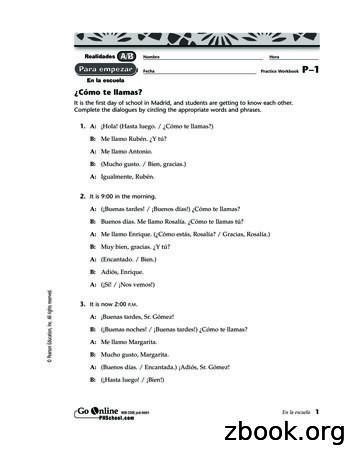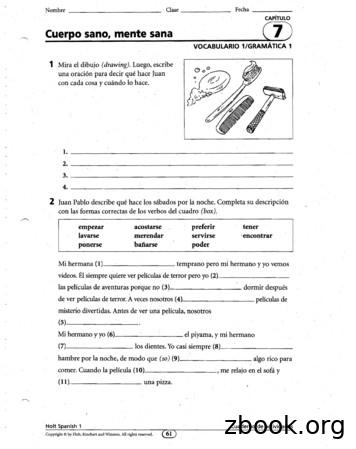Nombre Clase Fecha
NombreClaseDid You Get It?Goal:Level 1 p. 253Level 1B p. 48Presentación de gramáticaLearn the differences between ser and estar.Ser and estar There are two verbs in Spanish that mean to be. Read the sentences below, payingattention to the boldfaced verb in each. As you read each set of sentences, thinkabout what they are about.I am from the United States.The girls are nice.Raúl is an actor.It is one o’clock.The CDs are Alex’s.It is January 1st.origintraitprofessiontimepossessiondateYo soy de Estados Unidos.Las chicas son simpáticas.Raúl es actor.Es la una.Los discos compactos son de Alex.Es el primero de enero. Now read this set of sentences.I am in Spanish class.The boys are fine.The girls are happy.locationphysical conditionemotional conditionYo estoy en la clase de español.Los chicos están bien.Las chicas están contentas.EXPLANATION: Ser and estar both mean to be. There are six situations when you use ser:(1) to indicate origin, or where someone is from; (2) to describe personal traits or physicalcharacteristics; (3) to indicate professions; (4) to tell time; (5) to indicate possession;and (6) to give the date. There are three situations when you use estar: (1) to say wheresomeone or something is; (2) to describe a physical condition (usually health-relatedstates); and (3) to describe an emotional condition (usually feelings).4Unidad 5, Lección 1Reteaching and Practices1rb 0500 dygi.indd 4Copyright by McDougal Littell, a division of Houghton Mifflin Company.Reteaching and PracticeUNIDAD 5 Lección 1¡AVANZA!Fecha¡Avancemos! 1Unit Resource Book9/14/06 8:40:16 PM
NombreClaseDid You Get It?¡AVANZA!Goal:FechaLevel 1 pp. 254–255Level 1B pp. 49–51Práctica de gramáticaLearn the differences between ser and estar.UNIDAD 5 Lección 11 Answer the questions using the model as a guide.Modelo:¿De dónde es Juan? (de Quito)Juan es de Quito.¿Cómo es Luis? (simpático)2.¿De dónde es Andrea? (de Guayaquil)3.¿Cómo es el libro? (interesante)4.¿Cómo son los chicos? (inteligentes)5.¿Cómo es la clase de español? (divertida)6.¿De quién es el disco compacto? (de Jorge)7.¿Qué hora es? (1:30)8.¿Qué fecha es hoy? (4 de enero)9.¿Cómo son los chicos? (altos)10.Reteaching and Practice1.¿Qué es la señora López? (maestra)Copyright by McDougal Littell, a division of Houghton Mifflin Company.2 Answer the questions following the model.Modelo:1.¿Cómo está Linda? (bien)2.¿Dónde está Quito? (en Ecuador)3.¿Cómo están Paco y Ana? (cansados)4.¿Dónde está París? (en Francia)5.¿Cómo está Pedro? (triste)3 In the following sentences, which verb would you use, ser or estar?1.María is tall.6.Eduardo is studious.2.Tomás is worried.7.My sister is pretty.3.I am tired.8.My mother is in the car.4.They are in the garden.9.Anita is a brunette.5.We are students.¡Avancemos! 1Unit Resource Books1rb 0500 dygi.indd 5¿Dónde está Juan? (en la escuela)Juan está en la escuela.10.I am from Spain.Unidad 5, Lección 1Reteaching and Practice59/14/06 8:40:19 PM
NombreClaseFecha1.Nosotrosen la sala.2.La lámparade Quito.3.Los jardinesbonitos.4.Va a su cuarto porque5.Elloscansado.en la cocina.las seis de la tarde.6.7.Mi casa8.Luisal lado de su casa.alto.5 Translate the following sentences into Spanish.1.The fruit is from Florida.2.My brothers are in the kitchen.3.María’s dog is lazy.4.Mr. Velázquez is a teacher.5.María is studious.6.Today is July 4th.7.It is three o’clock.6 Use complete sentences to answer these questions about you, your house, and yourSpanish class.Sobre ti1.¿Cómo eres?2.¿De dónde eres?3.¿Cómo estás hoy?4.¿Dónde estás ahora?Tu casa5.¿Cómo es tu casa?6.¿Dónde está tu casa?Tu clase de español67.¿Cómo es tu clase de español?8.¿A qué hora es tu clase de español?Unidad 5, Lección 1Reteaching and Practices1rb 0500 dygi.indd 6Copyright by McDougal Littell, a division of Houghton Mifflin Company.Reteaching and PracticeUNIDAD 5 Lección 14 Complete each sentence with the correct form of ser or estar.¡Avancemos! 1Unit Resource Book9/14/06 8:40:22 PM
NombreClaseFecha¿Recuerdas?Level 1 p. 254Level 1B p. 49Location wordsUNIDAD 5 Lección 1 Review the following expressions to talk about location in Spanish.lejos de (far from)cerca de (near to)delante de (in front of)detrás de (behind)encima de (on top of)debajo de (under)al lado de (next to)dentro de (inside of)Reteaching and PracticePrácticaCopyright by McDougal Littell, a division of Houghton Mifflin Company.Use the location words above to describe where the following items are in relation toeach other. Follow the model.Modelo:la lámpara / la mesaLa lámpara está encima de la mesa.1.la alfombra / el sofá2.el sillón / la ventana3.las cortinas / la ventana4.la computadora / el escritorio5.el sillón / el sofá6.el escritorio / la sala7.el espejo / la ventana8.la lámpara / el sillón9.el sofá / la televisión¡Avancemos! 1Unit Resource Books1rb 0500 dygi.indd 11Unidad 5, Lección 1Reteaching and Practice119/14/06 8:40:41 PM
NombreClaseFechaLevel 1 p. 255, 259Level 1B pp. 50, 55¿Recuerdas? Review and study the following names of colors in Spanish.amarillo(a) (yellow)marrón (pl., marrones) (brown)anaranjado(a) (orange)negro(a) (black)azul (pl., azules) (blue)rojo(a) (red)blanco(a) (white)verde (green)Clothing Review the following Spanish words for clothes.Para los chicosla camisa (shirt)Para todosel gorro (winter hat)el sombrero (hat)la camiseta (T-shirt)la chaqueta (jacket)los calcetines (socks)los jeans (jeans)los pantalones (pants)los pantalones cortos (shorts)los zapatos (shoes)Para las chicasel vestido (dress)la blusa (blouse)PrácticaComplete the translation of the following sentences. The first one is done for you.pantalones azules1. Andrés lleva (blue pants)2.Los chicos llevan (black jeans).3.Yo llevo (a yellow dress).4.En el verano, llevas (a white T-shirt).5.Tú llevas (a green blouse).6.En el invierno, llevamos (black hats).7.Cuando hace frío, lleváis (a brown jacket).8.Nosotros llevamos (red shorts).9.Cuando hace calor, él lleva (a white hat).¡Jorge siempre lleva (orange shoes)!10.12.Unidad 5, Lección 1Reteaching and Practices1rb 0500 dygi.indd 12Copyright by McDougal Littell, a division of Houghton Mifflin Company.Reteaching and PracticeUNIDAD 5 Lección 1Colors¡Avancemos! 1Unit Resource Book9/14/06 8:40:45 PM
4. ¿Cómo son los chicos? (inteligentes) 5. ¿Cómo es la clase de español? (divertida) 6. ¿De quién es el disco compacto? (de Jorge) 7. ¿Qué hora es? (1:30) 8. ¿Qué fecha es hoy? (4 de enero) 9. ¿Cómo son los chicos? (altos) 10. ¿Qué es la señora López? (maestra) 2 Answer the questions following the model. Modelo: ¿Dónde está .
CLASE 28. El pretérito indefinido: otros verbos irregulares (II) CLASE 29. El imperfecto CLASE 30. El futuro CLASE 31. El imperfecto del subjuntivo CLASE 32. El condicional CLASE 33. Expresión de hipótesis CLASE 34. Pretérito pluscuamperfecto y listado de verbos irregulares CLASE 35. La forma pasiva y el discurso indirecto CLASE 36.
Necesito _ p a p e l p a r a l a clase de ciencias. a. pocas b. poco c. pocos 4. Necesito _ l á p i ce s p a r a l a clase de arte. a. mucho b. mucha c. muchos c b a c Nombre Clase Fecha GRAMÁTICA 1 La vida escolar CAPÍTULO 4 Indefinite articles The indefinite articles un and una mean a or an; the indefinite articles unos and .
Fecha Realidades Practice Workbook P–4 OC H E N T A Y DO S L C T MO J X U E Y S WH U S S R OGXL EG I L ECEHME GUN V C T B C R T U C G I OH C O Y A T N E R A U C N . 6 En la clase Nombre Hora Fecha Realidades Practice Workbook P–6 En la clase Modelo 25 libros WEB CODE jcd-0004 Real00.qxd (001-012) 6/12/03 7:57 AM Page 6 .
d) Mi brazo mide (4 m / 40 cm) de largo. e) La altura de mi pupitre es de (1 m / 10 cm). Completa los huecos con cm, o m. a) La altura de mi padre es de 175 . b) La correa del perro mide 1 de largo. c) La longitud del lápiz es de 10 . d) La cancha de baloncesto mide 30 de largo. 1 2 Nombre: Clase: Fecha: Material fotocopiable 2.º EP. Unidades .
Nombre _---- Clase _ Fecha _.,-- -'--_ CAPiTULO Cuerpo sano" mente sCina m . VOCABULARIO 1/GRAMATICA 1 . 1 Mira el dibujo (drawing). Luego, escribe
5 Clase Partes de la Definición Identificador de Clase: nombre Propiedades Atributos o variables: datos necesarios para describir los objetos (instancias) creados a partir de la clase La combinación de sus valores determina el ESTADO de un objeto Roles: relaciones que una clase establece con otras clases Servicios, operaciones, métodos (funciones miembro en C ): acciones
4. una compañera / Rosa / de clase / es Rosa es una compañera de clase. Él es El señor Porta es Ella es Marta es Yo soy Nombre Clase Fecha GRAMÁTICA 1 ¡Empecemos! CAPÍTULO 1 Subjects and verbs in sentences The subject of a sentence is the person, place, or thing being described or performing an action.
Trustee Joy Harris Jane Gardener Simon Hebditch Trustee Sarah Howell- Davies Jill Batty Cartriona Sutherland treasurer Verity Mosenthal Jenny Thoma Steve Mattingly Trustee Anne Sharpley Lynn Whyte Katy Shaw Trustee Sandra Tait Tina Thorpe Judith Lempriere The position of chair is contested so there will be an election for this post Supporting Statements David Beamish Standing for Chair I .























